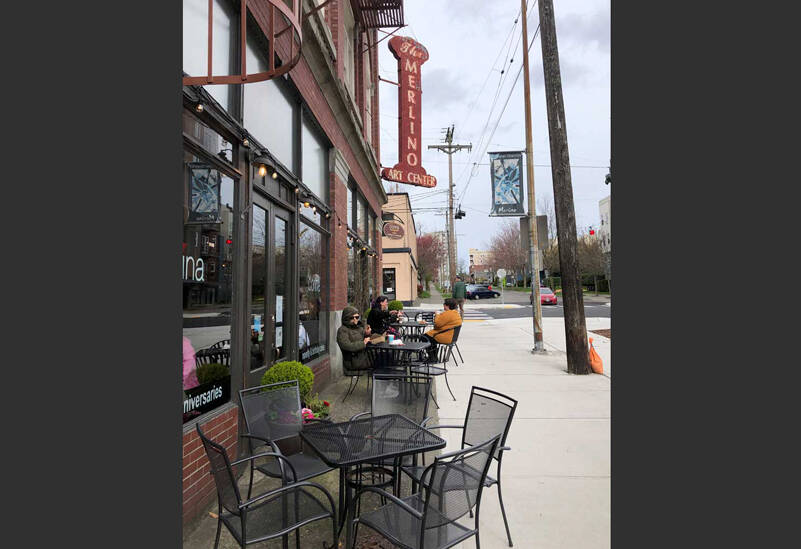By Morf Morford, Tacoma Daily Index
What is a stroad?
A stroad is something so familiar that most of us never even see, let alone recognize what it is – even though the average modern person spends a large chunk of our day within its grasp. A stroad is one of those all too common multi-laned thoroughfares you encounter in nearly every city, town, and suburb in America.
They’re what happens when a street (historically a free and public forum where people interact with businesses and others from the immediate area and where local transactions of all kinds occur) gets combined with a road – a high-speed route (as in quick exit) between these convivial and usually economically productive places.
In short, a stroad is the worst of both worlds. It is neither a forum for commerce, a safe place for pedestrians (and families) or a place for social gathering of any kind.
Stroads are massive stretches of lifeless pavement, usually loud and dense with vehicles where we spend much of our time, that other living things stay away from. They are also enormously expensive to build and maintain. They dominate, and undermine, many state and local budgets.
Stroads, in short, are designed for vehicles – and in most cases, vehicles only. No pedestrian, child, domestic or wild animal, or a motorist in distress is safe – or welcome – here.
The road
The central importance and value of a road is in the speed and efficiency that it provides for movement between destinations. Anything that impedes the speed and efficiency of a road, by definition devalues that road.
A core principle is that if we want to maximize the value of a road, we eliminate anything that reduces the speed and efficiency of travel. Which tends to mean literally any living thing – from tree to child to birds to migrating animals.
A street
A street is, at least over history, almost the exact opposite. A street has been, for millennia, the neighborhood marketplace, the setting for festivities and gatherings, where children are safe and welcome, and where the reigning sound is not that of machines, but of people bargaining, chatting or doing business.
Stroads, being the amalgamation of streets and roads are the urban design equivalent of multi-tasking where several tasks are done poorly in place of one done properly.
Streets, in other words, may have vehicle traffic – but it moves slowly. Roads are, by intention and design, where traffic goes fast – and any impediments are deliberately and necessarily minimized. It is possible, perhaps even desirable, to make this distinction when designing (and funding) transportation systems.
Oddly enough, when congestion was removed from many stroads across the country during the pandemic by a reduction in driving for many of us, especially during peak driving times, traffic fatalities went up. It turns out that traffic congestions, as much as we might hate being in it, actually saves lives. Many urban designers insist our highways, when unencumbered by congestion, are in fact dangerous by design.
You can see an analysis of deaths for pedestrians over the past several years here.
Freeways
Whether we love them or hate them, freeways excel at what they do. Freeways are, for better or worse, a single-purpose, dedicated transportation system with a clear purpose and set of priorities. Vehicles of a certain speed belong. Pedestrians, animals and cross streets do not. It could not be more simple.
Addicted to stroads?
The first steps to any recovery of addiction of any kind is to acknowledge that one has a problem. Could you go, for example, a day (or more) without the object of your addiction? Whether it is peanut butter, coffee, your smart phone, sugar or your car, could you go 24 hours without stressing or obsessing about its absence?
A reference to the dictionary definition of addiction might help here;
a compulsive, chronic, physiological or psychological need for a habit-forming substance, behavior, or activity having harmful physical, psychological, or social effects and typically causing well-defined symptoms (such as anxiety, irritability, tremors, or nausea) -Merriam-Webster
The next time you are on a street (or even better, a freeway) take a quick glance at the other drivers or passengers. How much anxiety or irritability do you see?
As you know, if you look at other drivers or passengers, it better be a “quick glance” – a longer look is, in almost every situation on American streets in the 2020s, seen as a threat, which, in an armed America, could easily (and often does) result in dangerous activity for many innocent people.
Not your father’s driving experience
“Road rage” as too many of us know first hand, is continually bubbling just below the surface of too many drivers and, for whatever reason, more and more drivers are armed – which has led to yet another problem few of us had anticipated – increasing numbers of thefts of guns from vehicles.
More than 180 cities reported increases in gun thefts from cars from 2019 to 2020. These thefts are now the largest source of stolen guns. The city of Tacoma in 2022 reported a theft of a gun from a vehicle every other day.
To put it simply, driving, where we drive and who is driving are not what they used to be.
We need to design our streets and neighborhoods accordingly.





